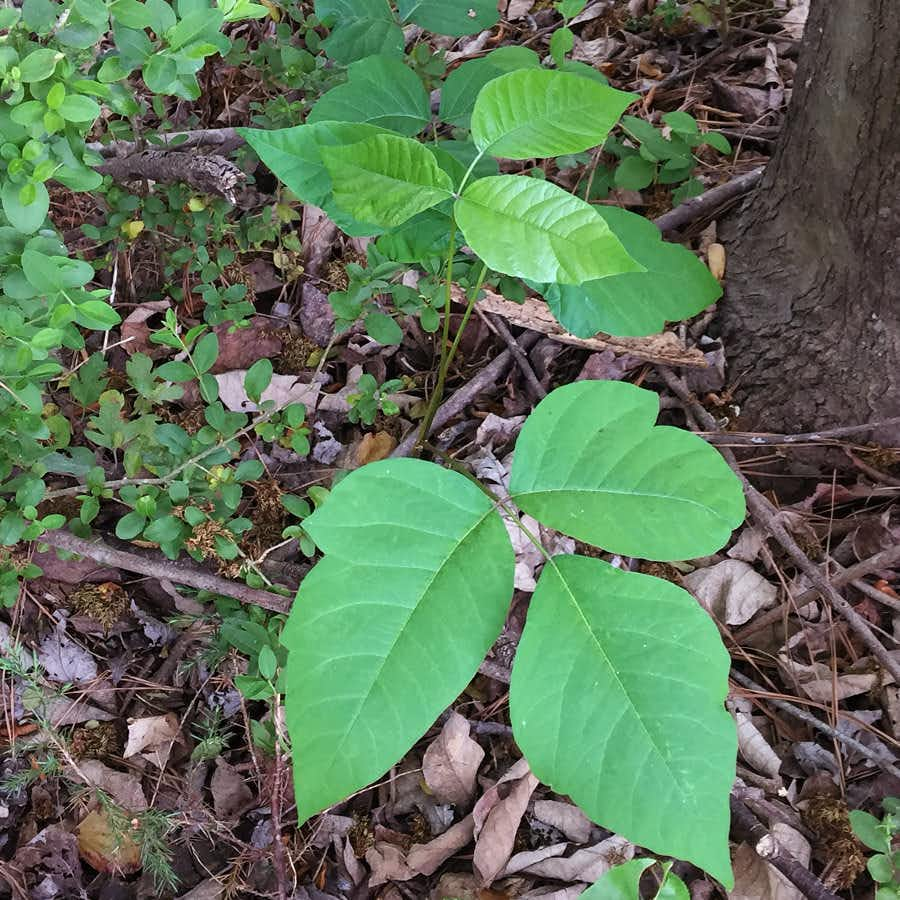
This is a scary time of year for millions of people who are sensitive to urushiol. That is the scientific name for the resin found on the leaves, stems or roots of poison ivy, poison oak and poison sumac. As many as 50 to 75 percent of American adults are sensitive to poison ivy, oak or sumac (Dermatitis, May/June 2019).
What Is the Problem with Poison Ivy?
Contact with this compound can lead to red, itchy patches that can range from mildly irritating to life threatening. People who breathe in smoke that contains urushiol can end up in the emergency department because of severe breathing problems.
Most people who are sensitive to poison ivy try very hard to avoid plants with the classic three-leafed pattern. Even if you don’t touch these leaves, though, you can still develop bumps, blisters and itching. That’s because your clothing may come into contact with the leaves while you are gardening or walking in the woods.
One woman told us about a terrible mistake she made after brushing up against poison ivy leaves. She was highly sensitive and realized immediately that she needed to remove her clothes before entering her house. Unfortunately, she sat on them while taking off her boots. If she had immediately taken a shower, she probably would have been OK. The rash she experienced was extremely unpleasant.
Poison Ivy Resin Can Spread from Animal Fur:
Cats, dogs and other animals can rub against poison ivy plants while they are outside.
One reader wrote:
“Three days before going on vacation my husband got poison ivy…from our dog. How do we know this? When my husband fishes our pup will wander off for short periods of time and come back and sit between his feet. The poison ivy was spread from the tops of his socks to the bottom of his shorts.”
Pets can bring urushiol inside on their fur. If you pet your buddy, you now have the irritating compound on your hands. It can be easily spread all over your body from this secondary contact. This may be a compelling reason to wash your hands well after caressing your pet.
Soap Is the First Line of Defense Against Poison Ivy:
If you know you have come into contact with urushiol, wash it off ASAP! In grandma’s day, people would have used brown laundry soap. Today we have Zanfel Poison Ivy Wash or Tecnu Outdoor Skin Cleanser. Such products can often prevent the itchy rash by removing the resin from your skin before it can cause damage. IvyX can be put on before going outside. It is a barrier cream that can partially protect the skin. It also makes it easier to wash off the resin.
FEG reported:
My mother believed and I have found that if you wash with a strong soap very well after being exposed to poison ivy, or sumac, you will experience very little problem. I have not had any problem from exposure for years.”
Could Witch Hazel Help?
Q. I recently developed a nasty poison ivy rash and tried every remedy I could think of. Then I read about witch hazel. I had some on hand, so I poured it over my rash after bathing.
Within a day, my poison ivy was healing and itched much less. To help it along, I put some witch hazel in a spray bottle and spritzed the rash several times a day. From now on I will keep witch hazel on hand to help ease the discomfort of poison ivy at the first sign of a rash.
A. Witch hazel (Hamamelis virginiana) has long been used as a topical treatment for skin irritation. Other readers have mentioned applying jewel weed (Impatiens capensis) or plantain (Plantago major) to ease the itch.
Of course, it is always better to avoid the problem in the first place. People who work outside often coat the skin with Tecnu, IvyBlock or Ivy Shield before exposure to protect it from the irritating resin. Zanfel can help wash off this allergenic oil after exposure.
How Can You Treat the Itchy Rash?
What can you do once you notice the red bumps and experience the itch? If it’s a mild case of poison ivy, a topical corticosteroid cream from the pharmacy may help. An odd home remedy might also be worth a try.
Some people tell us that a banana peel can be comforting:
“As a Girl Scout 40 years ago, I tried an experiment with banana peel on one spot of poison ivy and calamine lotion on the other spot. The spot where I applied the banana peel three to five times a day healed three days sooner. I am a believer.”
Hot Water Is Worth a Try:
Hot water can sometimes help ease the discomfort, especially the itch.
One reader shared this experience:
“I had a case of poison ivy covering my hands and arms. The intense itching was driving me crazy, even while taking a course of prednisone my doctor prescribed. I read about the hot water treatment to relieve itching and found that it did help a lot.”
The trick is to use water that is hot enough to be a bit uncomfortable but not enough to burn. A few seconds of exposure can take away the itch for a couple of hours. This treatment can be controversial, however, as we heard from this reader:
Q. You wrote about using hot water to relieve the itching from poison ivy. I too have found that very hot water relieved the itch.
However, my doctor told me it was one of the worst things I could do. We initially catch poison ivy from contact with the plant, but he said it spreads through our blood stream. Since hot water increases blood circulation, it will also speed the spread of poison ivy.
Dermatologists Promote Hot Water for the Itch:
A. Dermatologists disagree with your doctor. They state unequivocally that a poison ivy rash results from skin exposure to urushiol, the sticky irritating oil from poison ivy, poison oak and poison sumac. Because there is no evidence that poison ivy spreads through the blood stream, using hot water (not so hot that it burns) to ease the itch should not make a mild case worse.
Gloria H wrote about her experience:
“I was unknowingly exposed to poison ivy until the breakout appeared on both arms and legs. Relief came by patting with soapy water, using a blow dryer on hot setting, but not hot enough to burn skin, and then applying a heavy coating of pink calamine (the one I used contained 8% calamine – surprised to find the clear formula has no calamine in it).
“This relieved the itching for hours. When the itching would start again, I would repeat the process – hot setting on blow dryer, calamine. The pink calamine isn’t very appealing but when you are itching, appearance was the least of my worries. Unfortunately, poison ivy does not go away quickly – lasted about 7 days. If I had gotten it on my face, I would have gone to a doctor.”
RW agreed about the benefit of a blow dryer:
“I have also used the blow dryer treatment when I found it difficult to get water to stay hot enough. Instead of calamine lotion I followed up the heat application with moisturizing lotion with aloe in it. Otherwise the heat would dry out my skin badly.
“I have read that poison ivy symptoms only start to appear when the oil from the plant has bonded onto the skin. Once the itchy rash is present, the oil can no longer be spread to other body parts, fabric, clothing, etc. You can also get poison ivy oil on your skin from touching an animal’s fur after the animal has been through a poison ivy patch.
“I also read that how the heat treatment works is by releasing the histamines that are in the skin cells affected by the rash. Histamines are what causes the itching, so you could also try an anti-histamine for itch relief. After applying the heat the histamines build up again gradually in the skin, but it usually takes a couple of hours for the rash to start itching again. Essentially the heat treatment allows you to compress two hours worth of itching into a few seconds. At the same time the more pain you are feeling from the heat, the less itch you are able to feel. This is because pain and itch use the same nerves to send signals to the brain, and the nerves have a limit to the volume of signals they can transmit simultaneously.”
Milk of Magnesia to Soothe Poison Ivy Rash:
Heat is not the only remedy to stop the suffering. Other readers report that applying milk of magnesia to the rash also soothes the itch.
One reader shared this story:
“I used to get poison ivy all over after clearing the weeds and grass from my mowers in the Texas winds. I had to go to the doctor for a steroid shot to clear it up.
“One weekend, out of desperation, I first wiped all the rashes down with rubbing alcohol and then rubbed milk of magnesia all over them. It worked much better than calamine lotion. The rash stopped weeping and spreading, and best of all, the itching stopped too! It all cleared up quickly.”
A severe case of poison ivy requires medical attention. A potent corticosteroid cream or even oral prednisone may be necessary. A 15-day course with a tapering dose appears to be an effective treatment (Journal of Clinical Medicine Research, Dec. 2014).
Citations
- Kim Y et al, "Poison ivy, oak, and sumac dermatitis: What is known and what is new?" Dermatitis, May/June 2019. DOI: 10.1097/DER.0000000000000472
- Curtis G & Lewis AC, "Treatment of severe poison ivy: a randomized, controlled trial of long versus short course oral prednisone." Journal of Clinical Medicine Research, Dec. 2014. DOI: 10.14740/jocmr1855w


